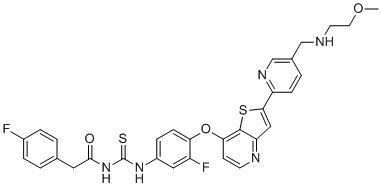
Glesatinib
CAS No. 936694-12-1
Glesatinib( MGCD-265 | MGCD265 | MGCD 265 )
Catalog No. M16709 CAS No. 936694-12-1
Glesatinib (MGCD-265) is a tyrosine kinase inhibitor that potently and selectively inhibits Met and Axl kinase.
Purity : >98% (HPLC)
 COA
COA
 Datasheet
Datasheet
 HNMR
HNMR
 HPLC
HPLC
 MSDS
MSDS
 Handing Instructions
Handing Instructions
| Size | Price / USD | Stock | Quantity |
| 5MG | 963 | Get Quote |


|
| 50MG | 1962 | Get Quote |


|
| 100MG | 2520 | Get Quote |


|
| 200MG | Get Quote | Get Quote |


|
| 500MG | Get Quote | Get Quote |


|
| 1G | Get Quote | Get Quote |


|
Biological Information
-
Product NameGlesatinib
-
NoteResearch use only, not for human use.
-
Brief DescriptionGlesatinib (MGCD-265) is a tyrosine kinase inhibitor that potently and selectively inhibits Met and Axl kinase.
-
DescriptionGlesatinib (MGCD-265) is a tyrosine kinase inhibitor that potently and selectively inhibits Met and Axl kinase.Lung Cancer Phase 2 Clinical.
-
In VitroGlesatinib (MGCD265; 0.01-5 μM; for 72 hours) results in a dose-dependent inhibition of cancer cell growth and shows the low IC50 value of 0.08 μM on NSCLC H1299 cells. Glesatinib (0.01, 0.1, 0.5, 1 μM) significantly increases by several-fold the percentage of apoptotic cells in NSCLC H1299 cells. Glesatinib has the cytotoxicity to P-gp overexpressing cancer cells KB-C2, SW620/Ad300, HEK293/ABCB1, and their parent cells KB-3-1, SW620, HEK293 cells with the IC50s fell between 5 and 10 μM. Glesatinib (1, 3 μM; 120 mins) increases the intracellular [3H]-Paclitaxel accumulation and inhibits [3H]-Paclitaxel efflux in cancer cell lines overexpressing P-gp. Glesatinib (0-40 μM) stimulates the ATPase activity of P-gp transporters in a dose-dependent manner. Cell Proliferation Assay Cell Line:NSCLC H1299 cells Concentration:0.01, 0.1, 1, 2, 5 μM Incubation Time:For 72 hoursResult:Resulted in a dose-dependent inhibition of cancer cell growth and showed the lowest IC50 value of 0.08 μM.
-
In VivoGlesatinib (MGCD265; 15 mg/kg/day; orally; 40 weeks) causes a significant decrease in tumor size. Animal Model:4?6-week old female balb/c athymic (nu/nu) mice with HCC827 NSCLC tumor xenografts Dosage:15 mg/kg Administration:Orally; daily; 40 weeks Result:Caused a significant decrease in tumor size.
-
SynonymsMGCD-265 | MGCD265 | MGCD 265
-
PathwayAngiogenesis
-
Targetc-Met/HGFR
-
Recptorc-Met/HGFR
-
Research AreaCancer
-
IndicationLung Cancer
Chemical Information
-
CAS Number936694-12-1
-
Formula Weight619.71
-
Molecular FormulaC31H27F2N5O3S2
-
Purity>98% (HPLC)
-
Solubility——
-
SMILESO=C(NC(NC1=CC=C(OC2=C3C(C=C(C4=NC=C(CNCCOC)C=C4)S3)=NC=C2)C(F)=C1)=S)CC5=CC=C(F)C=C5
-
Chemical NameN-((3-fluoro-4-((2-(5-(((2-methoxyethyl)amino)methyl)pyridin-2-yl)thieno[3,2-b]pyridin-7-yl)oxy)phenyl)carbamothioyl)-2-(4-fluorophenyl)acetamide
Shipping & Storage Information
-
Storage(-20℃)
-
ShippingWith Ice Pack
-
Stability≥ 2 years
Reference



-
Amivantamab
Amivantamab (JNJ-61186372) is a humanized antibody that recognizes epidermal growth factor receptor (EGFR) and MET proto-oncogene (MET).
-
MET inhibitor Compou...
A novel potent, selective orally bioavailable MET tyrosine kinase inhibitor with IC50 of <1 nM and 12 nM for unphosphorylated and phosphorylaed MET, respectively.
-
Capmatinib hydrochlo...
Capmatinib hydrochloride is an orally bioavailable inhibitor of the proto-oncogene c-Met (HGFR)with potential antineoplastic activity.Capmatinib was found to be highly selective for MET over other kinases.?It was active against cancer models that are characterized by MET amplification, marked MET overexpression, MET exon 14 skipping mutations, or MET activation via expression of the ligand hepatocyte growth factor (HGF).



 Cart
Cart
 sales@molnova.com
sales@molnova.com


